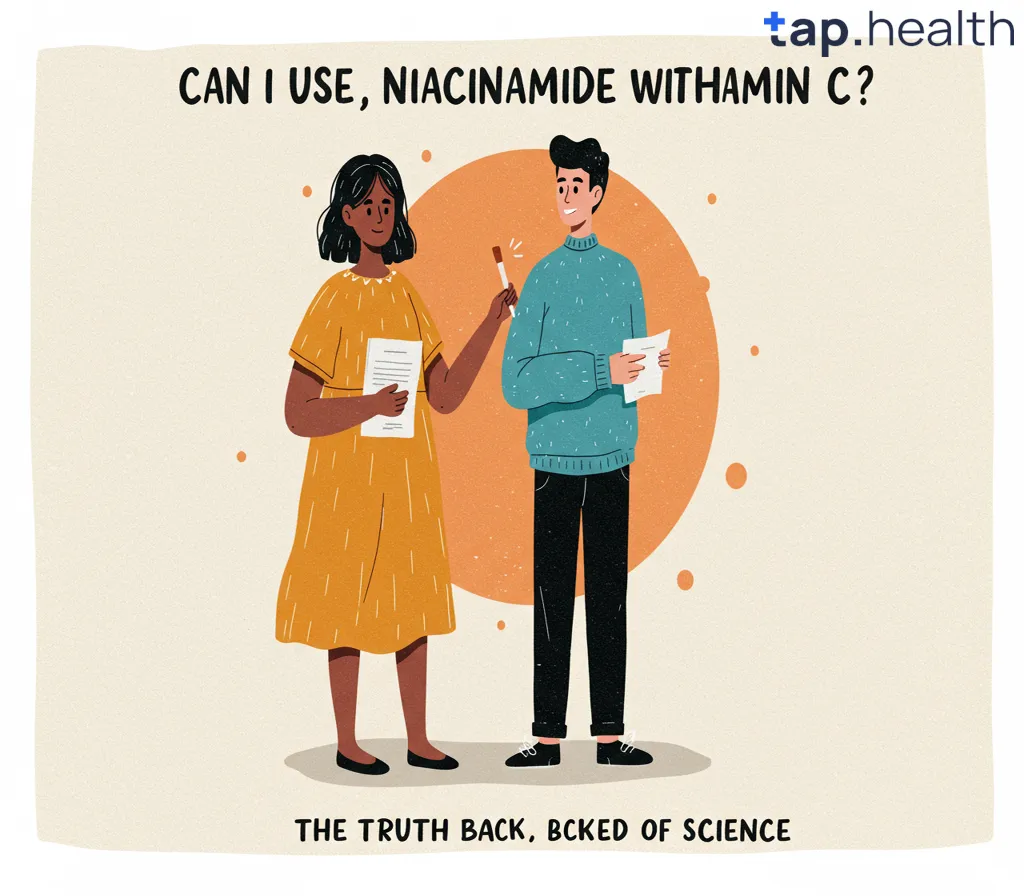Let’s be honest: skincare can feel like chemistry class all over again. You’ve got ingredients with long names, pH levels, and rules about what goes with what. It’s enough to make you want to just wash your face with water and call it a day.
But if you’re serious about clear, bright, healthy skin, two ingredients you’ve probably heard about are niacinamide and vitamin C. They’re like the A-list celebrities of skincare—everyone’s talking about them, and for good reason.
Now, here’s the big question that keeps popping up:
Can I use niacinamide with vitamin C?
Spoiler: Yes. But there’s more to it.
In this guide, we’ll break down everything you need to know—no confusing jargon, no fake hype. Just clear, simple, science-backed facts so you can use these two power players the right way and actually see results.
What Is Niacinamide and What Does It Do?
Before we talk about combining ingredients, let’s get to know them first.
Niacinamide 101: The Multi-Tasking Skincare Hero
Niacinamide is a form of vitamin B3. Don’t worry—you don’t need a biology degree to understand it. Just think of it as a gentle but powerful helper for your skin.
It’s water-soluble, which means it mixes well with water-based products like serums and toners. And the best part? It works for almost every skin type—dry, oily, sensitive, acne-prone, you name it.
Key Benefits of Niacinamide:
- Reduces redness and inflammation – Great for rosacea or irritated skin.
- Fades dark spots and evens skin tone – Helps with post-acne marks and sun damage.
- Strengthens the skin barrier – Keeps moisture in and irritants out.
- Minimizes pores – Makes them look smaller over time.
- Controls oil production – Perfect for oily or acne-prone skin.
- Boosts collagen – Helps keep skin firm and smooth.
Niacinamide is like that reliable friend who shows up for everything—birthdays, breakups, bad skin days. It doesn’t cause drama, and it just makes things better.
What Is Vitamin C and Why Is It So Popular?
Now let’s talk about vitamin C. You’ve probably heard it’s great for glowing skin—and that’s true. But what exactly is it?
Vitamin C (L-ascorbic acid) – The Brightening Powerhouse
Vitamin C is an antioxidant. That means it fights free radicals—those nasty molecules from pollution, UV rays, and stress that damage your skin and speed up aging.
The most effective form in skincare is L-ascorbic acid, though you’ll also see gentler versions like sodium ascorbyl phosphate or ascorbyl glucoside in sensitive skin formulas.
Key Benefits of Vitamin C:
- Brightens dull skin – Gives you that “I just came back from vacation” glow.
- Fades dark spots and hyperpigmentation – Helps even out skin tone.
- Protects against sun damage – Works best when used with sunscreen.
- Boosts collagen production – Fights fine lines and keeps skin firm.
- Reduces inflammation – Calms redness and breakouts.
Think of vitamin C as your skin’s personal bodyguard. It shields it from daily damage and keeps it looking fresh and youthful.
Can I Use Niacinamide with Vitamin C? The Real Answer
Alright, let’s get to the million-dollar question: Can I use niacinamide with vitamin C?
Yes. You absolutely can.
And not only can you use them together—you should. They’re like peanut butter and jelly. Coffee and toast. Batman and Robin.
They work better together.
But—and this is a big but—there’s a catch.
Back in the early 2000s, a study suggested that combining niacinamide and vitamin C could cause irritation or even turn your skin yellow. That study scared a lot of people, and the myth stuck.
But here’s the truth: That study used extreme lab conditions that don’t reflect real-life skincare use.
In normal, everyday skincare routines, using niacinamide and vitamin C together is not only safe—it’s smart.
Dermatologists and skincare experts now agree: You can layer them, mix them, or use them at different times of day. Just do it the right way.
Why Combining Niacinamide and Vitamin C Works So Well
When you use niacinamide and vitamin C together, you’re not just doubling up—you’re upgrading your entire skincare game.
Here’s how they team up:
1. They Fight Dark Spots in Different Ways
- Vitamin C blocks the enzyme (tyrosinase) that makes melanin—the pigment behind dark spots.
- Niacinamide stops melanin from transferring to the top layers of your skin.
So while vitamin C stops the production, niacinamide stops the delivery. It’s like cutting off a supply chain.
Result? Faster fading of acne marks, sun spots, and melasma.
2. They Strengthen Your Skin Barrier
- Niacinamide boosts ceramides—fats that keep your skin strong and hydrated.
- Vitamin C supports collagen, which gives your skin structure and bounce.
Together, they help your skin stay firm, plump, and protected from irritants.
3. They Calm Inflammation
Both ingredients reduce redness and swelling. That’s great if you deal with acne, rosacea, or sensitive skin.
Using them together means less irritation and faster healing.
4. They Protect Against Environmental Damage
Vitamin C is a powerful antioxidant. Niacinamide helps repair damage from UV and pollution.
Pair them, and your skin gets double protection—even before you apply sunscreen.
Will Niacinamide and Vitamin C Cancel Each Other Out?
This is a common fear. Let’s clear it up.
No, they do not cancel each other out.
The old theory was that vitamin C (which is acidic) and niacinamide (which can turn into niacin at high heat and low pH) might react and cause flushing or irritation.
But modern research and real-world use show this doesn’t happen in properly formulated skincare products.
Reputable brands test their formulas to make sure ingredients stay stable and effective. So if you’re using a good serum, you don’t need to worry.
Bottom line: No neutralization. No wasted product. Just better skin.
Can You Mix Niacinamide and Vitamin C in the Same Product?
Yes—and many brands already do.
You’ll find serums and moisturizers that contain both niacinamide and vitamin C in one bottle. These are often called “brightening” or “anti-aging” serums.
Examples include:
- The Ordinary Niacinamide 10% + Zinc 1% (can be layered with vitamin C)
- Paula’s Choice 10% Niacinamide Booster
- SkinCeuticals Discoloration Defense (has both)
- Good Molecules Niacinamide Brightening Toner + Vitamin C
As long as the product is well-formulated and stored properly (away from light and air), it’s safe and effective.
Just check the ingredient list and avoid anything with alcohol, fragrance, or harsh preservatives if you have sensitive skin.
How to Use Niacinamide and Vitamin C Together (The Right Way)
Now that we know you can use them together, let’s talk about how to use them.
There are a few safe methods. Pick the one that fits your skin type and routine.
Method 1: Layer Them in the Same Routine
You can apply both in the morning or at night—just follow the thinnest to thickest rule.
Step-by-step:
- Cleanse your face.
- Apply vitamin C serum (it’s usually thinner and water-based).
- Wait 1–2 minutes for it to absorb.
- Apply niacinamide serum or moisturizer.
- Finish with sunscreen (if it’s morning).
Tip: If your skin feels tight or stings, reverse the order. Try niacinamide first, then vitamin C.
Some people find that niacinamide calms the skin, making it more tolerant of vitamin C.
Method 2: Use Vitamin C in the Morning, Niacinamide at Night
This is a great option if you have sensitive skin.
- AM: Vitamin C + moisturizer + sunscreen
(Vitamin C gives antioxidant protection during the day.) - PM: Niacinamide + night cream
(Niacinamide helps repair and strengthen your skin overnight.)
This way, you still get the benefits of both—without overwhelming your skin.
Method 3: Use a Combo Product
If you want simplicity, pick a serum that has both ingredients.
Just make sure it’s from a trusted brand and stored in an opaque, air-tight bottle (vitamin C breaks down in light and air).
Can You Use Them If You Have Sensitive Skin?
Yes—but go slow.
Sensitive skin doesn’t mean you can’t use active ingredients. It just means you need to be gentle.
Tips for Sensitive Skin:
- Start with lower concentrations:
- Vitamin C: 5–10% L-ascorbic acid (or use a gentler form like magnesium ascorbyl phosphate).
- Niacinamide: 5% or less.
- Patch test first—apply a small amount behind your ear or on your jawline.
- Introduce one ingredient at a time. Wait a week before adding the second.
- Use them every other day at first, then build up to daily use.
- Avoid combining with other actives like retinol or exfoliants at first.
If your skin turns red, itchy, or starts peeling, stop and give it a break. You can try gentler versions or consult a dermatologist.
What Strengths Should You Use?
Not all formulas are created equal. Using the right concentration matters.
Vitamin C Strengths:
- 5–10%: Good for beginners and sensitive skin.
- 10–15%: Ideal for most people—effective but not too harsh.
- 20%+: Strong, but can be irritating. Best for experienced users.
Higher isn’t always better. A 10% well-formulated serum often works better than a 20% unstable one.
Niacinamide Strengths:
- 2–5%: Great for sensitive or dry skin.
- 5–10%: Most common and effective for oily, acne-prone, or aging skin.
- 10%+: Can be drying for some. Not necessary for most people.
The Ordinary’s 10% niacinamide is popular, but if it makes your skin flaky, try a 5% version or mix it with a moisturizer.
Can You Use Them with Other Actives?
Yes, but be smart about it.
With Retinol?
Yes, but not all at once.
Retinol, vitamin C, and niacinamide are all powerful. Using all three in one routine can cause irritation.
Better approach:
- AM: Vitamin C + niacinamide + sunscreen
- PM: Retinol (2–3 times a week) + niacinamide or moisturizer
Niacinamide can actually help reduce retinol irritation—so it’s a great sidekick.
With AHAs/BHAs (like glycolic or salicylic acid)?
Yes, but space them out.
Exfoliants can make your skin more sensitive. If you’re using acids, apply them at night and use vitamin C in the morning.
Or, use acids one night and vitamin C the next.
With Hyaluronic Acid or Peptides?
Absolutely. These are gentle and hydrating.
In fact, pairing vitamin C or niacinamide with hyaluronic acid helps prevent dryness and boosts plumpness.
Best Products with Niacinamide and Vitamin C
Want to make life easier? Here are some top-rated, dermatologist-approved products that combine both or work well together.
1. Paula’s Choice 10% Niacinamide Booster
- Lightweight serum
- Can be mixed with moisturizer or other serums
- Great for oily and acne-prone skin
2. SkinCeuticals C E Ferulic
- Gold-standard vitamin C serum
- Contains vitamin C, E, and ferulic acid
- Pricy but highly effective
- Can be layered with niacinamide
3. The Ordinary Vitamin C Suspension 23% + HA Spheres
- Strong, gritty texture
- Best for experienced users
- Pair with their Niacinamide 10% + Zinc 1% (but not at the same time if sensitive)
4. Glossier Super Pure Serum
- 5% niacinamide + hyaluronic acid
- Gentle, hydrating, good for sensitive skin
5. Olay Regenerist Vitamin C + Niacinamide Moisturizer
- Drugstore favorite
- Combines both actives in a creamy formula
- Great for beginners
Pro Tip: Store vitamin C products in a cool, dark place. Keep the cap on tight. If it turns brown, it’s oxidized—toss it.
Common Myths About Niacinamide and Vitamin C
Let’s bust some myths so you don’t waste money or stress out.
Myth 1: They React and Cause Yellow Skin
False. This comes from an old lab study using extreme heat and pH. It doesn’t happen in real-life use.
Myth 2: You Should Never Layer Them
False. Many dermatologists recommend layering them. Just let each product absorb before applying the next.
Myth 3: Only One Can Work at a Time
False. They work on different pathways. Using both gives you more benefits.
Myth 4: Vitamin C Is Too Harsh for Daily Use
False. If formulated well, vitamin C is safe for daily use. Start slow if you’re new.
Myth 5: Niacinamide Makes You Flush
Only if it turns into niacin—which happens under extreme conditions, not in skincare. If you feel warmth or redness, it might be sensitivity, not a chemical reaction.
Signs You Should Stop Using Them Together
Even safe combinations can go wrong if your skin says no.
Stop and reassess if you notice:
- Stinging or burning after application
- Redness or rash that doesn’t go away
- Peeling or flaking beyond mild dryness
- Breakouts (could be purging or irritation)
- Worsening of acne or rosacea
If this happens:
- Stop both products for a few days.
- Reintroduce one at a time.
- Use a gentle moisturizer and barrier-repair cream.
- Consider seeing a dermatologist.
Sometimes, it’s not the ingredients—it’s the formula. Fragrance, alcohol, or poor packaging can make even good ingredients irritating.
How Long Does It Take to See Results?
Patience is key.
You won’t wake up with glass skin overnight. But with consistent use, here’s what to expect:
- 2–4 weeks: Less oiliness, fewer breakouts, calmer skin
- 4–8 weeks: Brighter complexion, fading dark spots
- 8–12 weeks: Smoother texture, firmer skin, visible glow
Stick with it. Skincare is a marathon, not a sprint.
And always wear sunscreen. UV exposure undoes all the good work vitamin C and niacinamide do.
Can You Use Them During Pregnancy?
Yes, both are generally considered safe during pregnancy.
- Niacinamide: Safe, non-hormonal, great for pregnancy acne and melasma.
- Vitamin C: Also safe and helpful for brightening pregnancy-related dark spots.
But always check with your doctor before starting new skincare, especially if you’re using prescription products or have health concerns.
Avoid vitamin C serums with added retinoids or hydroquinone during pregnancy.
Final Tips for Best Results
Want to get the most out of your niacinamide and vitamin C routine? Follow these simple tips:
- Start slow – Introduce one product at a time.
- Use sunscreen daily – Both ingredients make your skin more sun-sensitive.
- Store products properly – Keep vitamin C in a dark, cool place.
- Don’t overdo it – More isn’t better. One vitamin C and one niacinamide product are enough.
- Listen to your skin – If it feels tight, red, or irritated, scale back.
- Be consistent – Results come with regular use, not magic.
Frequently Asked Questions (FAQ)
Can I use niacinamide and vitamin C every day?
Yes, most people can use both daily. Start with every other day if you have sensitive skin, then build up to daily use.
Can I mix niacinamide and vitamin C in my hand before applying?
It’s not recommended. Mixing them manually can affect stability. Instead, layer them one after the other, letting each absorb first.
Does vitamin C make niacinamide less effective?
No. Modern research shows they remain effective when used together in skincare products.
Can I use them if I have acne?
Yes! Both help with acne. Niacinamide reduces oil and inflammation. Vitamin C fades post-acne marks and boosts healing.
Which should I apply first—niacinamide or vitamin C?
Apply the thinnest product first. Usually, vitamin C goes first because it’s more watery. But if it stings, try niacinamide first—it can soothe the skin.
Can I use them with sunscreen?
Yes, and you should! Apply vitamin C in the morning, then niacinamide (if using), then moisturizer, then sunscreen. Vitamin C boosts sun protection.
Do they expire?
Yes. Vitamin C oxidizes (turns brown) when exposed to air and light. Use within 3 months of opening. Niacinamide is more stable but still has a shelf life—check the expiration date.
Can they cause purging?
Not usually. Purging is linked to exfoliants like retinoids or acids. But if you’re using a product with added exfoliants, that might cause purging.
Is it safe to use with other vitamins?
Yes. Niacinamide and vitamin C work well with vitamins E, A (retinol), and B5 (panthenol). Just don’t overload your skin.
Can men use them?
Absolutely. Skincare isn’t gender-specific. These ingredients help with razor burn, dark spots, and aging—common concerns for all.
Can teens use niacinamide and vitamin C?
Yes, especially for acne and dark marks. Just use gentle formulas and avoid high concentrations.
What happens if I stop using them?
Your skin may slowly lose the benefits—like dullness returning or dark spots reappearing. But there are no withdrawal effects. You can start again anytime.
The Bottom Line: Yes, You Can (And Should) Use Them Together
So, can you use niacinamide with vitamin C?
Yes.
They don’t fight. They team up.
They don’t cancel each other out. They boost each other.
And when used the right way, they can transform your skin—making it brighter, clearer, stronger, and healthier.
Forget the old myths. Listen to science. Listen to your skin.
Start slow. Be consistent. Protect your skin with sunscreen.
And get ready to glow—naturally.



